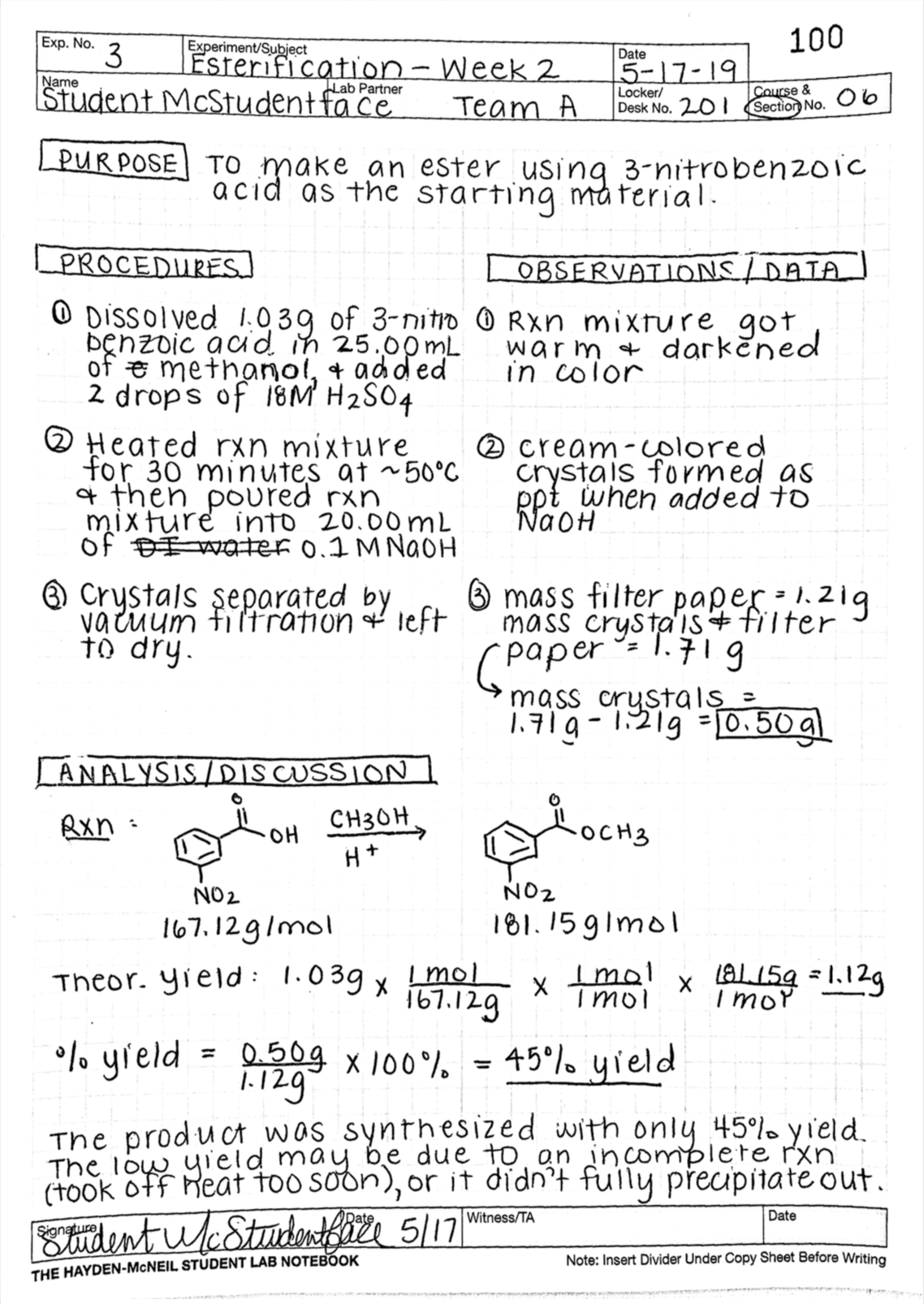Part 7: Assignment Guides
26 Notebook and Team Contribution
The Laboratory Notebook
You will be required to keep a laboratory notebook for the duration of this course. The notebook is preferably bound, with the pages numbered consecutively for easy reference. The preferred notebook is the carbonless copy type, in which each page is reproduced twice so that both you and your laboratory instructor can keep a copy of your lab notes. Since we are going green, you can also choose an electronic notebook.
The notebook is a day-to-day record of your activities in the lab and can only be completed while in lab. It is the place where you will describe experiments as you do them and note observations as you make them. It is where you will record and analyze your data. Your notebook will be an invaluable tool throughout the semester, as you must have an accurate record of what you did and what you observed in the laboratory when the time comes to write your laboratory reports.
All data, results and weights, etc. should be recorded directly into your notebook in ink. Loose pieces of paper might easily get lost. Remember that it is to your benefit to keep a detailed notebook which will make it easier for you to reconstruct the experiment accurately in a report later. Any mistakes should be crossed out but still legible, so that one can see what change was made. Do not erase or cover mistakes with white-out.
The notebook should not be a neatly copied reiteration of the laboratory procedure. Rather, you should write what you did and observed. Neatness, spelling, punctuation and grammar are not essential in this notebook. “Perfection” is not expected, but it should be possible for someone else to repeat your work by reading your account, i.e., it should be legible and intelligible. Your data and notes will be shared with your lab partners to help coordinate the team’s overall analysis and summary of the work. This can be done by taking a picture on your phone, scanning your notebook pages, or typing up what you did, and then sharing it with your lab partners (e.g., by email or on a shared drive).
Since the lab notebook should be used for recording everything that you do in the laboratory, there is not one particular format that can be used for all situations, so it is important to be flexible. However, there are certain things you should do to make the lab notebook as useful as possible:
- Leave a few pages blank at the beginning of the notebook. As you begin new experiments and projects you can use these pages to prepare a table of contents that can be updated as you go.
- Make sure all the pages are numbered.
- Make sure that each page is signed and dated. Although this may not be so important in an introductory lab, it is certainly good practice, and is required in many research labs.
- Because each team member should have a purpose (as described in the planning document), each person should have a “mini lab report” by the end of the day. This purpose, e.g., “My goal this session is to test for the presence of different cations in unknown #273,” should be written at the start of your notebook pages for the day.
- Finally, when you are done experimenting, you should analyze your data and summarize your work for the day.
At the end of each lab period, you will be required to turn in the photo of notebook pages or electronic version of notebook record to D2L. Your instructor will grade your notebook pages based on quality of notebook and attendance/participation. Note that your notebook grade will be assigned a “0” for lab absences.
Team Contribution (Laboratory Citizenship)
In addition to what you have recorded in your laboratory notebook, your instructor will pay attention to how appropriately you comported yourself in the laboratory. Some things they may consider include, but may not be limited to, the following: timeliness, safety, fulfillment of team role, participation, respectfulness, cleanliness, punctuality, etc.
Sample Lab Notebook Page
Here is an example of what a lab notebook page might look like. You are not limited to one page per lab session; use as many as you need. Remember to put something behind the corresponding copy page (your notebook may have come with a thick cardstock page) so that your writing does not bleed through to the next blank page!

Notebook & Team Contribution Success Guide
Your lab instructor will read your notebook in order to see whether you are keeping up with your work, whether you understand what you are doing, and whether you are recording everything you need. This guide will be uploaded into D2L, and your lab instructor will comment on strengths of your work and contributions to the team as a citizen of the laboratory, as well as offer suggestions for improvement. This assignment is worth 20 points, 10 for notebook record and 10 for team contribution (laboratory citizenship).
|
Goals for Notebook Page(s) |
Strengths & Suggestions for Improvement |
|
|---|---|---|
|
Record of Individual Lab Work |
|
|
|
Purpose |
Is there a clear purpose to the experiments performed by the individual student during the lab session? |
|
|
Procedures |
Is the procedure clear, reproducible, and reflective of the actual steps taken and amounts used? |
|
|
Data and Calculations |
|
|
|
Conclusions |
Does the individual offer any conclusions as to the results of the experiment? |
|
|
Lab Citizenship |
Up to 10 points, at the discretion of your instructor, based on performance in lab (e.g., following safety protocol, wearing PPE, cleanliness, teamwork, etc.) |
|

